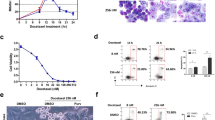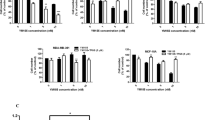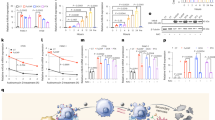Abstract
Survivin is expressed in most cancers but is undetectable in differentiated adult cells, and plays an important role both in the suppression of apoptosis and mitotic spindle checkpoint; thus it has attracted great interest as a potential drug target. In this study, we investigated the antigene and antiproliferative effects of triplex-forming oligodeoxynucleotides (TFO) targeting survivin in human lung carcinoma A549 cells. Survivin-specific TFOs form stable triplexes under physiological conditions as tested by electrophoretic mobility shift assays. Treatment of A549 cells with survivin-specific but not control TFOs at a concentration of 400 nM in the presence of uptake-enhancing liposome significantly reduced survivin protein level, inhibited cell proliferation, and induced cell apoptosis as demonstrated by immunoblot, cell number counting, and Annexin V-staining. Moreover, we found that the triplex-forming potential of TFOs measured in vitro does not necessarily correlate with the ability of TFOs to affect expression of a targeted gene in vivo. Our results indicate that targeting survivin is a promising alternative strategy for the development of novel anticancer therapeutics.
This is a preview of subscription content, access via your institution
Access options
Subscribe to this journal
Receive 12 print issues and online access
$259.00 per year
only $21.58 per issue
Buy this article
- Purchase on Springer Link
- Instant access to full article PDF
Prices may be subject to local taxes which are calculated during checkout




Similar content being viewed by others
References
Deveraux Q, Reed J . IAP family proteins: suppressor of apoptosis. Genes Dev. 1999;13:239–252.
Reed JC . The survivin saga goes in vivo. J Clin Invest. 2001;108:965–969.
Miller L . An exegesis of IAPs: salvation and surprises from BIR motifs. Trends Cell Biol. 1999;9:323–328.
Deveraux QL, Takahashi R, Salvesen GS, et al. X-linked IAP is a direct inhibitor of cell death proteases. Nature. 1997;388:300–304.
Roy N, Deveraux QL, Takahashi R, et al. The c-IAP-1 and c-IAP-2 proteins are direct inhibitors of specific caspases. EMBO J. 1997;16:6914–6925.
Deveraux QL, Leo E, Stennicke H, et al. Cleavage of human inhibitor of apoptosis protein xiap results in fragments with distinct specificities or caspases. EMBO J. 1999;18:5242–5251.
Duckett CS, Nava VE, Gedrich RW, et al. A conserved family of cellular genes related to the baculovirus iap gene and encoding apoptosis inhibitors. EMBO J. 1996;15:2685–2689.
Liston P, Roy N, Tamai K, et al. Suppression of apoptosis in mammalian cells by NAIP and a related family of IAP genes. Nature. 1996;379:349–353.
Ambrosini G, Adida C, Altieri D . A novel anti-apoptosis gene, surviving, expressed in cancer and lymphoma. Nat Med. 1997;3:917–921.
Li F, Ambrosini G, Chu EY, et al. Control of apoptosis and mitotic spindle checkpoint by survivin. Nature. 1998;396:580–584.
Adida C, Crotty PL, McGrath J, et al. Developmentally regulated expression of the novel cancer anti-apoptosis gene surviving in human and mouse differentiation. Am J Pathol. 1998;152:43–49.
Madden SL, Zhang L, Lash AE, et al. Analysis of human transcriptomes. Nat Genet. 1999;23:387–388.
Li F, Ackermann E, Bennett C, et al. Pleiotropic cell-division defects and apoptosis induced by interference with survivin function. Nat Cell Biol. 1999;1:461–466.
Olie RA, Simoes-Wüst AP, Baumann B, et al. A novel antisense oligonucleotide targeting survivin expression induces apoptosis and sensitizes lung cancer cells to chemotherapy. Cancer Res. 2000;60:2805–2809.
Mesri M, Wall NR, Li J, et al. Cancer gene therapy using a survivin mutant adenovirus. J Clin Invest. 2001;108:981–990.
Pennati M, Colella G, Folini M, et al. Ribozyme-mediated attenuation of survivin expression sensitizes human melanoma cells to cisplatin-induced apoptosis. J Clin Invest. 2002;109:285–286.
Jansen B, Schlagbauer-Wadl M, Hellmann N, et al. bcl-2 Antisense chemosensitizes human melanoma in SCID mice. Nat Med. 1998;4:232–234.
Nicholson DW . From bench to clinic with apoptosis-based therapeutic agents. Nature. 2000;407:810–816.
Faria M, Giovannangeli C . Triplex-forming molecules: from concepts to applications. J Gene Med. 2001;3:299–310.
Moser HE, Dervan PB . Sequence-specific cleavage of double helical DNA by triple helix formation. Science. 1987;238:645–650.
Vasquez KM, Marburger K, Intody Z, et al. Manipulating the mammalian genome by homologous recombination. Proc Natl Acad Sci USA. 2001;98:8403–8410.
McGuffie EM, Pacheco D, Carbone GMR, et al. Antigene and antiproliferative effects of a c-myc-targeting phosphorothioate triple helix-forming oligonucleotide in human leukemia cells. Cancer Res. 2000;60:3790–3799.
Faria M, Wood CD, Perrouault L, et al. Targeted inhibition of transcription elongation in cells mediated by triplex-forming oligonucleotides. Proc Natl Acad Sci USA. 2000;97:3862–3867.
Xu XS, Glazer PM, Wang G . Activation of human γ-globin gene expression via triplex-forming oligonucleotide (TFO)-directed mutations in the γ-globin gene 5′ flanking region. Gene. 2000;242:219–228.
Vasquez KM, Narayanan L, Glazer PM . Specific mutations induced by triplex-forming oligonucleotides in mice. Science. 2000;290:530–533.
Takebayshi Y, Pourquier P, Zimonjic DB, et al. Antiproliferative activity of ecteinascidin 743 is dependent upon transcription-coupled nucleotide-excision repair. Nat Med. 2001;7:961–966.
Shen C, Buck A, Mehrke G, et al. Triplex forming oligonuleotide targeted to 3′UTR downregulates the expression of the bcl-2 proto-oncogene in HeLa cells. Nucleic Acids Res. 2001;29:622–628.
Ikeguchi M, Kaibara N . Survivin messenger RNA expression is a good prognostic biomarker for oesophageal carcinoma. Br J Cancer. 2002;87:883–887.
Monzo M, Rosell R, Felip E, et al. A novel anti-apoptosis gene: Re-expression of survivin messenger RNA as a prognosis marker in non-small-cell lung cancers. J Clin Oncol. 1999;17:2100–2104.
Cogoi S, Rapozzi V, Quadrifoglio F, et al. Anti-gene effect in live cells of AG motif triplex-forming oligonucleotides containing an increasing number of phosphorothioate linkages. Biochemistry. 2001;40:1136–1143.
Acknowledgements
We thank Stephen Meier for technical assistance. This work is supported by German BMBF grant and IZKF_C10, University of Ulm.
Author information
Authors and Affiliations
Corresponding author
Rights and permissions
About this article
Cite this article
Shen, C., Buck, A., Polat, B. et al. Triplex-forming oligodeoxynucleotides targeting survivin inhibit proliferation and induce apoptosis of human lung carcinoma cells. Cancer Gene Ther 10, 403–410 (2003). https://doi.org/10.1038/sj.cgt.7700581
Received:
Published:
Issue Date:
DOI: https://doi.org/10.1038/sj.cgt.7700581
Keywords
This article is cited by
-
Inhibition of transcription by platinated triplex-forming oligonucleotides
JBIC Journal of Biological Inorganic Chemistry (2012)
-
Effect of hypoxia-inducible factor-1α on transcription of survivin in non-small cell lung cancer
Journal of Experimental & Clinical Cancer Research (2009)
-
Differential regulation of survivin expression and apoptosis by vitamin D3 compounds in two isogenic MCF-7 breast cancer cell sublines
Oncogene (2005)



